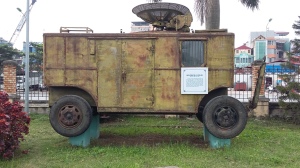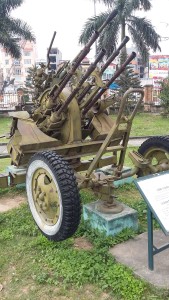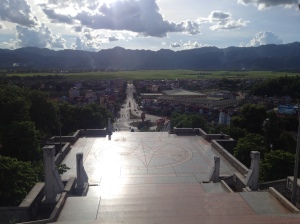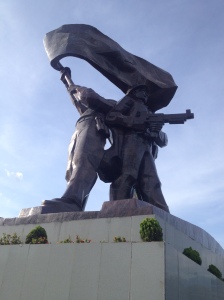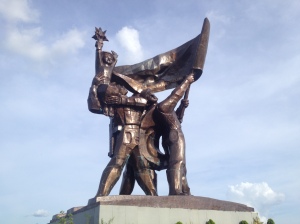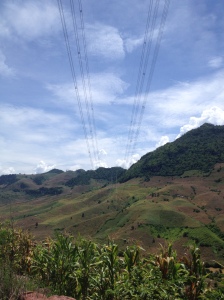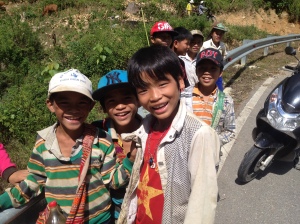I came across a museum that I have not been to before. It was the Air Force Museum and focusses mainly on the American War. The lessons of that war bear repeating. Technological and financial superiority are no guarantee of victory. Led by the genius of General Võ Nguyên Giáp and the tenacity and humility of Hồ Chí Minh, the Vietnamese people did not collapse and give up despite being subjected to the heaviest carpet bombing in history (“The bombing of North Vietnam surpassed the total tonnage of bombs dropped on Germany, Italy, and Japan in World War II“) as well as being sprayed with Agent Orange in what must be history’s severest deliberate poisoning of another country (43 million litres at concentrations of over 20 times the normal agricultural level).
Two quotes that give a flavour of what their enemies (including at various times Japan, France, the US, and China) were up against.
General Võ Nguyên Giáp: “Strike to win, strike only when success is certain, if it is not, then don’t strike.”
Hồ Chí Minh: “You will kill ten of us, we will kill one of you, but in the end, you will tire of it first.”
Today is the 40th anniversary of the desperate, iconic flight from the roof of the American Embassy in Saigon, the end of the war, even though bizarrely it was fully two years after the Nobel Peace Prize had been awarded by a Norwegian committee to Henry Kissinger and Lê Đức Thọ. The latter, uniquely in the prize’s history, declined the award. He was disgusted by the American violation of a truce when they had heavily bombed Hanoi the previous Christmas, and reasonably pointed out that in any case peace had not yet been achieved.
Hồ Chí Minh also said “the great victory of April 30 represents the triumph of the entire nation, of justice over brutality and of humanity over tyranny.”
Getting into the museum captured some of the quixotic, laidback and confusing way of the world around here. I asked the uniformed late-teenage guard where I should park my bike. He said “Over there, but the museum is closed”. I thought, “Well, the gate is open and you have let me in, so let’s see”. I parked and went back to him. He now said “You need to buy a ticket. 40 000 VND”. I ploddingly went to the ticket booth where I saw that indeed it didn’t open for another half hour. I turned to go, and the boy, who hadn’t moved an inch, said “You pay me”. I can’t recall seeing him put my money into a cash till. Anyway, ticket in hand I walked alone amongst the planes and anti-aircraft weaponry up to the grand building with its impressive staircase. Inside the door there were several military personnel, mainly women, testing the PA system. The museum itself was in darkness. They said, “It is closed”. I stood there blankly, adjusted my glasses and looked vaguely around. Eventually one said, “But you can go and look”. So I wandered around in the penumbra while the speakers squealed with the equivalent of “Testing, one-two, one-two”.
There was quite a range of technological complexity. On the one hand, there was body armour… made of something like straw
Even so long afterwards, it is still hard to fully assimilate the idea that people equipped like this could defeat the US. This painting purports to show a man from the H’re ethnic minority who shot down three helicopters with 10 bullets.
On the other hand, there was a photograph that I didn’t understand but that appears to show a Vietnamese astronaut. I have just looked it up and he was in fact (and of course) a cosmonaut. Called Phạm Tuân, he was the first non-Russian Asian in space, was up there for over a week, orbiting Earth 142 times, and if, dear non-Vietnamese reader, you tell me you already knew this, I won’t believe you.
Here was a chair that the legend informs us “many times utilized by Uncle Ho”
And outside was a helicopter that transported Hồ Chí Minh around.

As I got back on my bike, a convoy of non-military SUVs passed through the gate, stuffed with military personnel staring at me. We sized each other up. “This museum ain’t big enough for the both of us”, I telepathised. Their top boy stared back and perhaps he was thinking, “You want trouble, son?”. As imaginary skirmishes go, it was up there with the time I stood up to Millwall. In the end I did what perhaps others should have done, rode away from it, in fact fled to a nearby café.

